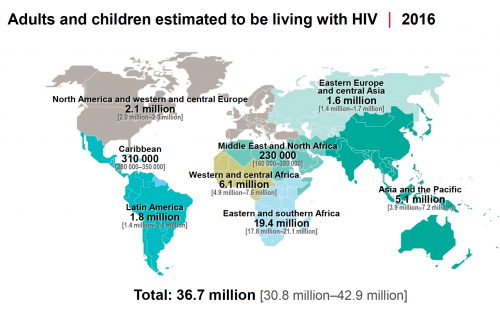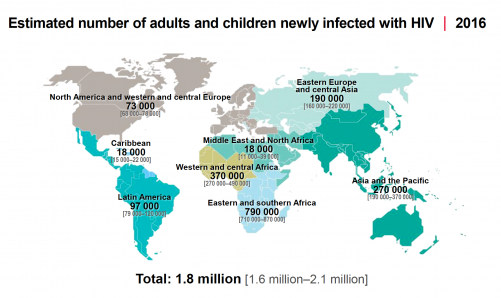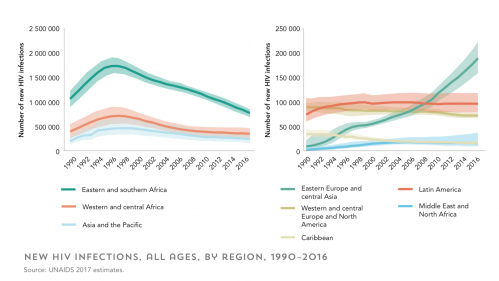In 2014, the Joint United Nations Programme on HIV/AIDS (UNAIDS) boldly called for nations to get 90 percent of their HIV populations diagnosed, 90 percent of that group on antiretrovirals (ARVs) and 90 percent of that group virally suppressed. Accomplishing this feat by 2020, the agency’s mathematical models projected, would send national epidemics on a path toward ending HIV as a public health threat by 2030.
Hitting the so-called 90-90-90 target would mean that 73 percent of a national HIV population would have an undetectable viral load. Thanks to the preventive power of HIV treatment—a huge body of research has indicated that such full suppression of the virus is associated with effectively zero chance of transmission—reaching this high rate of viral suppression, UNAIDS predicts, puts a nation at a crucial tipping point that would ultimately lead to epidemic control.

French AIDS ambassador Michèle Boccoz, executive director of UNAIDS Michel Sidibé, mayor of Paris Anne Hidalgo and Christine Kafando, a community health worker from Burkina Faso, speak at a Paris press conference on the 2016 90-90-90 UNAIDS report.Benjamin Ryan
But what constitutes a controlled epidemic? Despite the persistent calls for an “end to AIDS” throughout the decade—as in the French expression in the photo above—scientists still haven’t agreed upon what such a feat would entail.
Seeking answers, in October 2017, UNAIDS convened a large team of global experts in Glion, Switzerland, to hammer out just what the agency means by epidemic control. They honed in on four key metrics:
- A percentage reduction in a nation’s annual HIV infection rate, or number of new infections per year, known as incidence.
- The ratio of incidence over a nation’s annual death rate.
- The ratio of incidence over the total number of people living with the virus in a nation, known as prevalence.
- The incidence rate as a proportion of a nation’s population.
Five researchers recently published an essay in The Lancet HIV critiquing these criteria. Lead author Alison P. Galvani, PhD, of the Center for Infectious Disease Modeling and Analysis at the Yale School of Public Health, and her coauthors relied on mathematical modeling to determine how the four metrics would apply to sub-Saharan Africa through 2030.
These researchers argue that the first three metrics are problematic means of determining the success of efforts to control national HIV epidemics; only the fourth, they say, is a reliable and widely applicable metric for this purpose.

The bulk of the HIV epidemic is in the combined regions of West and central Africa and Eastern and southern Africa.UNAIDS

New HIV infections are heavily concentrated in sub-Saharan Africa.UNAIDS
Percentage reduction in incidence:
UNAIDS claimed in 2014 that reducing national HIV incidence levels from those seen in 2010 by 90 percent would end AIDS as a public health threat in each nation that achieved this feat. But as the Lancet HIV authors figure, such a reduction would not necessarily reduce the population-based infection rate to an acceptably low rate in every nation. After all, some hard-hit countries already have incidence rates 10 times greater than what might be considered acceptable.
For example, a 90 percent reduction in the national incidence rate in Niger would result in an impressively small 0.14 new infections per 10,000 residents, while in Lesotho, such a reduction would leave 21 per 10,000 residents contracting HIV annually. That’s a population-based incidence rate in Lesotho larger than Niger’s current rate, and Niger’s epidemic is certainly not safely in the “controlled” column at this point.

Changes in the annual number of new HIV infections by global regionSource: UNAIDS

Changes in the annual number of AIDS-related deaths by global regionSource: UNAIDS
Incidence-to-mortality ratio:
If more people living with HIV die each year than contract the virus, the incidence-to-mortality ratio is less than 1.0. This translates to a declining HIV prevalence, presuming there is no significant immigration of people with the virus. According to the Lancet HIV essay authors, for most sub-Saharan African nations, a sub-1.0 incidence-to-mortality ratio occurs along with declining incidence of the virus—which is, of course, a good sign.
Not so in South Africa. Currently, 86 percent of the HIV population in that hard-hit nation is diagnosed, 65 percent of that group is on treatment for the virus and 81 percent of that group is virally suppressed, for an overall viral suppression rate of just 45 percent. Accordingly, the Lancet HIV paper’s modeling projects that, if the status quo were to prevail, the South African HIV incidence would rise to more than 350,000 new infections in 2035, or 104 infections per 10,000 people. But more than 360,000 South Africans with HIV would die that year, putting the incidence-to-mortality ratio, or IMR, below 1.0, which would suggest—quite misleadingly—that the epidemic is being brought under control.
In recent years, HIV epidemiologists have sounded the alarm on the “youth budge” that has developed in sub-Saharan Africa, where more than half the population is younger than 20 years old. Individuals in this age bracket could contract HIV at a lower rate than members of the previous generation did at the same age and yet still see greater numbers of people acquiring the virus.
If such a youth-bulge-driven effect were to come to pass, “alarmingly high mortality among older individuals would become necessary to compensate for the demographic imbalance and thereby reduce the IMR to less than 1.0,” the Lancet authors write.
New York state’s ambitious Blueprint to End the AIDS epidemic, designed by a wide network of stakeholders and launched by Governor Andrew Cuomo in 2014, relies on the incidence-to-mortality ratio as a key metric that will “bend the curve” against the state’s sizable epidemic. Even as the death rate among New Yorkers with HIV follows its own long decline, the blueprint authors hope to accelerate the decline in the rate of HIV diagnoses, from 3,000 in 2012 to just 750 in 2020, such that the trajectories of the two rates will intersect.
At a 2014 press conference announcing the blueprint, Cuomo, who was reelected to a third term this week, said, “The end of the AIDS epidemic in New York state will occur when the total number of new HIV infections has fallen below the number of HIV-related deaths.”

Governor Andrew Cuomo, endorsing New York State’s Blueprint to End the AIDS Epidemic in front of New York City’s LGBT Center, April 2015Benjamin Ryan
In 2016, an estimated 2,100 people contracted HIV in New York State, while 1,968 of the approximately 122,000 HIV-positive residents died.
The Lancet HIV paper’s authors note that the U.S. President’s Emergency Plan for AIDS Relief (PEPFAR) has indicated that to rely on the incidence-to-mortality ratio definition of HIV epidemic control in any particular country, at least 70 percent of a nation’s population of HIV-positive people needs to be on ARVs. Just three of the 38 sub-Saharan nations that the essay’s authors assessed have an HIV treatment rate above 70 percent, making the incidence-to-mortality ratio definition of epidemic control sweepingly inapplicable, according to PEPFAR’s yardstick.
What’s more, of the 13 nations that the United States has prioritized for HIV-based foreign aid, just one, Côte D’Ivoire, has an incidence-to-mortality ratio below 1.0 at this time. Just 41 percent of that nation’s HIV population is on HIV treatment.
About 70 percent of New York state residents living with diagnosed HIV were virally suppressed in 2016. (The 2020 target is 85 percent.)
In July, numerous top experts took to the pages of The Lancet to demand a strengthened global response to the HIV pandemic. In their paper, these researchers challenged the wisdom of anticipating an “end to AIDS,” connecting such optimistic sloganeering with the “dangerous complacency” that might have contributed to the recent decline in global funding for HIV-related aid to poorer nations.
In their recent critique of the four UNAIDS metrics for epidemic control, the Lancet HIV essayists echo such concerns about the danger of seeing the future of the pandemic through rose-tinted glasses. “For countries with an IMR already less than 1,” they state, “the appearance of success even in the face of unacceptably high incidence could dampen the sense of urgency needed to forestall many new infections.”
Incidence-to-prevalence ratio:
As opposed to the incidence-to-mortality ratio, the incidence-to-prevalence ratio, or IPR, increases along with a high death rate. But what IPR value would indicate control of an HIV epidemic? The Lancet HIV paper authors say the answer to that question remains particularly muddy given all the moving parts that play into the ratio.
The researchers point to the fact that the life span of people living with HIV varies considerably between nations in the sub-Saharan African region. The fact that people with HIV in one nation are living long lives could—through the lens of the incidence-to-prevalence ratio metric—mask a high incidence.
Additionally, since HIV prevalence is in part a reflection of the number of years citizens live with HIV, if people contract the virus earlier in life, the incidence-to-prevalence ratio would decline, albeit for an undesirable reason. The youth budge raises the probability of such an outcome.
“As with the IMR,” the authors write, “interpretation of the IPR would thus require disentangling the effects of demography and transmission, which diminishes the utility of the metric of a criterion for epidemic control.”
Incidence-based criteria:
Relying on the annual population-based infection rates would get dispense with the need for mathematical disentangling and would provide a much clearer metric of how well a nation is controlling HIV, the Lancet HIV essay authors argue.
Such a straightforward metric could be applied from nation to nation and would also fall in line with the World Health Organization’s (WHO) definition of control of mother-to-child transmission of HIV: hitting 50 or fewer such transmissions per 100,000 live births among mothers with the virus and an overall mother-to-child transmission rate below 5 percent among mothers who breast-feed and below 2 percent among non–breast-feeding mothers. (HIV transmits through breast milk.)

Istock (Model(s) used for illustrative purposes only)
So the Lancet authors propose defining control of an HIV epidemic as reaching an annual infection rate below 1 per 10,000 people in any given nation, similar to how WHO defines control for other diseases. They propose setting the goal of reducing incidence to 1 in 1,000 by 2030 and to 1 in 10,000 by 2035—milestones that are in line with the modeling behind the UNAIDS 90-90-90 targets.
New York State has just crossed the 1 in 10,000 incidence threshold.
A note of caution about relying on national statistics, however: Such figures may mask trends among smaller subgroups, such as sex workers or men who have sex with men, among whom transmission rates may remain concerningly high even as the overall rate in the population at large is impressively small.
Benjamin Ryan is POZ’s editor at large, responsible for HIV science reporting. His work has also appeared in The New York Times, New York, The Nation, The Atlantic and The Marshall Project. Follow him on Facebook, Twitter and on his website, benryan.net.







Comments
Comments